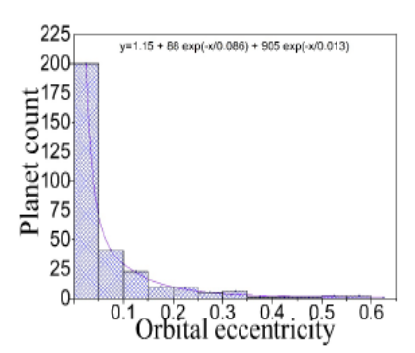


Indian Journal of Science and Technology
DOI: 10.17485/IJST/v16i40.2045
Year: 2023, Volume: 16, Issue: 40, Pages: 3471-3478
Original Article
Soumyabrata Mondal1*
1Department of Physics, Bidhannagar College, Salt Lake, 700064, West Bengal, India
*Corresponding Author
Email: [email protected]
Received Date:11 August 2023, Accepted Date:13 September 2023, Published Date:27 October 2023
Objectives: Hot Jupiters, a special class of exoplanets always draw attention due to their intriguing characteristics. Here we wish to establish the differentiation of two planetary mass groups having orbital eccentricity discrimination. Methods: A comprehensive statistical approach has been carried out to understand the distribution of hot Jupiter population and the architecture of those planetary. 312 hot Jupiters have been filtered out from 4285 different scientifically recognized exoplanet databases and such a huge hot Jupiter sample size has not been used to find out any intrinsic correlation before. Different techniques to discover hot Jupiters have been studied here to segregate them. Relation between orbital eccentricity and other planetary parameters like mass, orbital periods have been investigated further to find any intrinsic characteristics. Findings: We established that transit method has better chances to discover light and short period candidates. Their orbital eccentricity has been studied w.r.t. their calculated planetary mass and orbital period. We have found eccentricity excitation and tidal circularisation due to low orbital period keeps hot Jupiters at close proximity to their parent stars. Effectively smaller average eccentricity of for intermediate and large hot Jupiters indicates lack of influence of tidal interaction on larger masses. Probability distribution of eccentricity supports the existence of a discontinuity in planetary mass distribution at ~4MJ. Low p value (~0.037) in KS test indicates the existence of bimodal distribution of hot Jupiter populations having possibly different channel of formation. Novelty: Application of statistics on hot Jupiters is rare due to their infrequent detection. Already reported planetary parametric features of exoplanets are checked for trueness and new parameters have been studied. Here we also discussed theoretical and empirical implications of these statistical results for dynamical evolution. It opens up a new dimension to scientific realm.
Keywords: Hot Jupiter, Exoplanet, Mass distribution, Eccentricity, Transit method, Bimodal distribution
© 2023 Mondal. This is an open-access article distributed under the terms of the Creative Commons Attribution License, which permits unrestricted use, distribution, and reproduction in any medium, provided the original author and source are credited. Published By Indian Society for Education and Environment (iSee)
Subscribe now for latest articles and news.